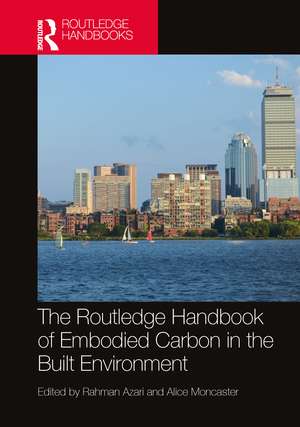The Routledge Handbook of Embodied Carbon in the Built Environment
Editat de Rahman Azari, Alice Moncasteren Limba Engleză Hardback – 22 dec 2023
Split into five distinct sections, international experts, researchers, and professionals present the recent developments in the field of embodied carbon from various perspectives and at different scales of material, building, and city. Following an introduction to the embodied carbon question, the chapters in Section 1 then cover the key debates around issues such as the politics of embodied carbon, links between embodied carbon and thermal mass, and the misuse of carbon offsets. Section 2 reviews the embodied carbon policies in a selected number of countries. Sections 3, 4, and 5 approach the topic of embodied carbon from urban-, building-, and material-scale perspectives, respectively, and use case studies to demonstrate estimation techniques and present opportunities and challenges in embodied carbon mitigation.
This will be important reading for upper-level students and researchers in Architecture, Urban Planning, Engineering, and Construction disciplines. Presenting case studies of embodied carbon assessment, this book will also help practicing architects, engineers, and urban planners understand embodied carbon estimation techniques and different mitigation strategies.
Preț: 1223.36 lei
Preț vechi: 1751.43 lei
-30% Nou
Puncte Express: 1835
Preț estimativ în valută:
234.10€ • 245.53$ • 194.88£
234.10€ • 245.53$ • 194.88£
Carte tipărită la comandă
Livrare economică 01-15 aprilie
Preluare comenzi: 021 569.72.76
Specificații
ISBN-13: 9781032234861
ISBN-10: 1032234865
Pagini: 486
Ilustrații: 69 Tables, black and white; 78 Line drawings, black and white; 66 Halftones, black and white; 144 Illustrations, black and white
Dimensiuni: 174 x 246 mm
Greutate: 1.22 kg
Ediția:1
Editura: Taylor & Francis
Colecția Routledge
Locul publicării:Oxford, United Kingdom
ISBN-10: 1032234865
Pagini: 486
Ilustrații: 69 Tables, black and white; 78 Line drawings, black and white; 66 Halftones, black and white; 144 Illustrations, black and white
Dimensiuni: 174 x 246 mm
Greutate: 1.22 kg
Ediția:1
Editura: Taylor & Francis
Colecția Routledge
Locul publicării:Oxford, United Kingdom
Public țintă
Postgraduate and Undergraduate AdvancedCuprins
SECTION 1: Introduction: The embodied carbon questions and debates 1. Introduction to this handbook - the question of embodied carbon 2. Minimising embodied carbon: A question of politics, not percentages 3. Climate-neutral and circular built environment - right here, right now - 4. Net zero in buildings and construction: Use and misuse of carbon offsets 5. Characterization of links between embodied carbon and thermal mass SECTION 2: Embodied decarbonization, approaches and policies 6. Introduction to Section 2: National and international approaches to and policies for decarbonisation 7. Embodied decarbonization in North America: A paradigm shift 8. Embodied carbon in building regulation – development and implementation in Finland, Sweden and Denmark 9. Global carbon budgets for the built environment: How far are we to achieve a 1.5°C limit in global warming? A Swiss example 10. The Levels framework and the Life Levels project: Developing common and national approaches to embodied carbon in European countries 11. Embodied emissions - knowledge building for industry SECTION 3: Urban scale perspectives 12. Introduction to Section 3: Embodied carbon and urban scale perspectives 13. Approaches and system boundaries for urban carbon accounts 14. Quantifying the sunk carbon costs of cities: A case-study of 50 years of construction in Odense, Denmark 15. Embodied GHG in transportation infrastructure SECTION 4: Building Scale Perspectives 16. Introduction to Section 4: Embodied carbon and building scale perspectives 17. Life cycle assessment applied to the eco-design of urban projects in France 18. Climate and resource footprint assessment in building information modelling: A method and indicators 19. Achieving social justice and environmental justice in safe affordable housing through a materials-centered, multi-level, transdisciplinary approach 20. Embodied carbon and building retrofit; a heritage example SECTION 5: Material scale perspectives 21. Introduction to Section 5: Embodied carbon and material scale perspectives 22. Real and apparent variations in embodied carbon impacts provided in EPD for construction products 23. Three windows: Accounting for embodied resources and cultural value 24. Embodied carbon in biogenic and earth materials: Accounting for the work of the biogeosphere in construction materials 25. Farm to building: Catalyzing the use of natural, net-zero, and healthier building materials
Notă biografică
Rahman Azari, PhD., is an architect, Associate Professor of architecture, and Director of the Resource and Energy Efficiency [RE2] Lab at the Pennsylvania State University (USA). Azari is also affiliated with the Penn State Institutes of Energy and the Environment (IEE), the Hamer Center for Community Design, and the Stuckeman Center for Design Computation (SCDC). Azari’s research on carbon-neutral buildings and cities has been supported by research grants from the US Department of Energy (DOE), the Council on Tall Buildings and Urban Habitat (CTBUH), and the American Institute of Architects (AIA).
Alice Moncaster, PhD., is a civil and structural engineer by background, whose work in industry has strongly influenced her subsequent career in academia. From July 2023 she is Professor of Sustainable Construction at the University of the West of England, and retains visiting positions at her two previous institutions, the Open University, and the University of Cambridge. She has been one of the UK experts for the International Energy Agency Annexes 57, 72, and 89 working with colleagues from around the world on developing a better understanding of embodied and whole life carbon of buildings, and on its implementation into policy and industry practice.
Alice Moncaster, PhD., is a civil and structural engineer by background, whose work in industry has strongly influenced her subsequent career in academia. From July 2023 she is Professor of Sustainable Construction at the University of the West of England, and retains visiting positions at her two previous institutions, the Open University, and the University of Cambridge. She has been one of the UK experts for the International Energy Agency Annexes 57, 72, and 89 working with colleagues from around the world on developing a better understanding of embodied and whole life carbon of buildings, and on its implementation into policy and industry practice.
Descriere
This handbook explores embodied carbon across the built environment.
